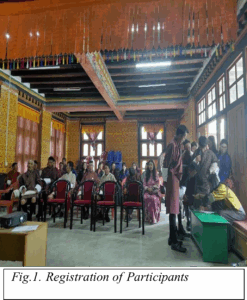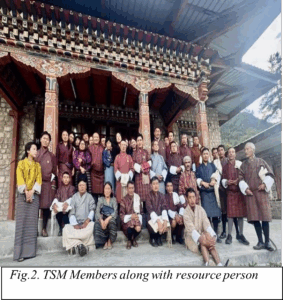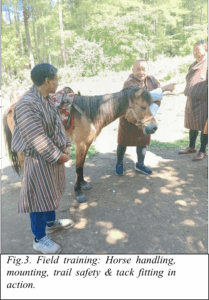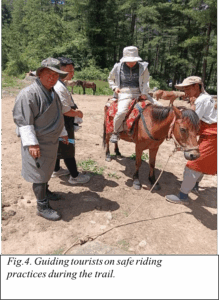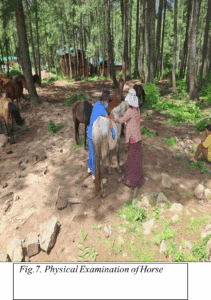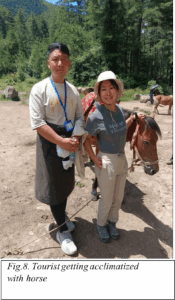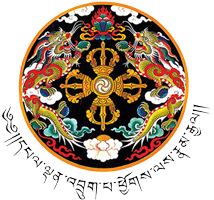REPORT ON THE MASS HEALTH SCREENING AND RIDING HORSE MANAGEMENT AWARENESS PROGRAM
Date:10/07/2025 – 11/07/2025
Location:
Day 1: Meeting Hall, Tsento Gewog Centre
Day 2: Ramthangka, Tsento Gewog, Paro Dzongkhag Organized by: Dzongkhag Livestock Sector, Paro Collaboration and Expertise:
The program was organized with technical support and field participation from:
-
- The National Equine Farm, Bumthang, who provided guidance on equine health and best management practices.
-
- The In-Charge of the Royal Stable, who shared experience on behavioral conditioning, handling standards, and riding safety protocols.
Background:
The awareness and health screening program were organized as part of a broader initiative to enhance the safety, welfare, and quality of pony riding services along the Taktsang trail. It aimed to build the capacity of the Taktsang Services Management Group (TSMG) by strengthening their understanding of proper horse management practices and ensuring the fitness of horses used for riding. The program focused on both improving equine welfare and addressing safety concerns for riders visiting the site. Accordingly, Day One involved an awareness session covering key topics such as feeding, grooming, handling, and rider safety, delivered with technical support from the National Equine Farm, Bumthang, and the Royal Stable. Day Two was dedicated to the mass health screening of riding horses and ponies at Ramthangka to assess their condition and suitability for trail services.
DAY ONE- AWARENESS PROGRAM ON EQUINE MANAGEMENT
On the first day of the program, an awareness session was held for the Taktsang Services Management Group (TSMG), supported by technical experts from the National Equine Farm, Bumthang, and the In-charge of the Royal Stable. The session aimed to strengthen the group’s knowledge on essential horse management practices, focusing on equine health, welfare, and safety. It included presentations, interactive discussions, and practical demonstrations to enhance service quality and ensure the well-being of horses used for pony rides along the Taktsang trail.
Key activities included:
-
- Presentation on equine health, nutrition, and welfare
-
- Discussions on broader equine-related challenges and solutions
-
- Feeding practices using locally available resources
-
- Regular deworming and preventive health care
-
- Ensuring access to clean drinking water
-
- Daily grooming and hygiene maintenance
-
- Safe handling and proper use of grooming and safety equipment
-
- Early training of horses for trail riding and obstacle navigation
-
- Selection of fit, healthy horses for riding services
-
- Recommendation to use riding hats to improve rider safety
DAY TWO- HEALTH SCREENING
Activity Highlights
-
- Hands-on demonstration: Field-based training on the second day included practical demonstrations on proper horse handling, rider mounting/dismounting, trail safety, and tack fitting.
2. Health Screening:
-
- Fecal Sample Analysis: All collected samples showed the consistent presence of strongyle eggs, indicating parasitic load.
- Blood Sample Analysis: No hemoprotozoan parasites were detected in the screened horses.
-
- Vital Parameters: Rectal temperature, heart rate, respiratory rate, and mucous membrane color were within normal physiological ranges across all horses examined.
- Fecal Sample Analysis: All collected samples showed the consistent presence of strongyle eggs, indicating parasitic load.
-
- Owner Feedback: Most owners admitted to not maintaining a deworming schedule, despite using the horses regularly for riding services.
Key Observations
-
- Horses generally appeared healthy, but lack of regular deworming can predispose them to performance and welfare issues in the long term.
-
- Awareness among horse owners is limited, particularly regarding parasite control, behavioral training, and eligibility criteria for riding animals.
-
- Safety concerns remain unaddressed, as there is no standardized body or guideline currently in place to assess and certify horses fit for riding services.
Conclusion
The field activity culminated in the realization of an urgent need to establish a formal riding horse eligibility system tailored to Bhutanese horses. This system should:
-
- Define clear criteria for the fitness of horses used in riding based on health, behavior, temperament, and management standards.
- Be backed by a regulatory or certifying authority to implement and enforce riding safety protocols.
-
- Involve all relevant stakeholders, including veterinary professionals, local government, tour operators, and equine service providers.
- Define clear criteria for the fitness of horses used in riding based on health, behavior, temperament, and management standards.
Recommendations
-
- Establish Riding Horse Certification Criteria
- Develop guidelines to assess riding fitness, covering physical health, behavior under saddle, response to handling, and tack suitability.
- Designate a Certifying Authority
- Form a local Riding Pony Certification Committee under the Dzongkhag Livestock Sector in coordination with the National Equine Farm and the Tourism Council of Bhutan.
- Implement a Deworming and Vaccination Schedule
- Need for a thrice in a year deworming schedule mainly March, July and November which will be really helpful in eliminating most internal parasites
- Promote Welfare-Based Horse Management
- The urgent need for certified safety helmets for the riders, if possible gloves as it helps in grip
- Limit load per horse based on body condition and fitness level.
-
- Create an Incident Reporting Mechanism
- Establish Riding Horse Certification Criteria
Set up a simple reporting system to document accidents, near-misses, or unsafe behavior by horses or handlers along tourist trails.
Annexure:
